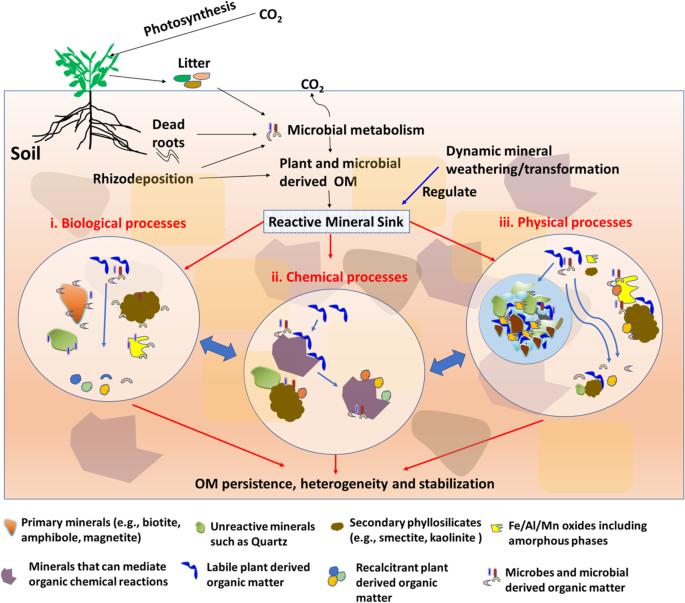“Reactive Mineral Sink” drives soil organic matter dynamics and stabilization
引用次数: 0
Abstract
Reactive primary and secondary minerals play a critical role in the transformation and stabilization of organic matter (OM) in soil, a critical aspect that has been largely overlooked in existing literature. In this regard, we propose a new model known as the “reactive mineral sink” (RMS) to illustrate three primary mechanisms through which these minerals drive the bioprocessing, transformation, transport and stabilization of OM in soil. Firstly, from a biological perspective, reactive minerals influence enzymatic and microbial OM processing through binding enzymatic proteins or influencing the structure of microbial communities. Secondly, from a chemical standpoint, these minerals have the capacity to adsorb OM and/or coprecipitate with it, leading to a more diverse distribution of OM in the soil. This distribution, in turn, triggers OM transformation through chemical catalysis and redox reactions. Thirdly, on a physical level, reactive minerals have a substantial impact on soil architecture, aggregate dynamics, porosity development, and hydrological processes. These physical changes then affect the transport, reprocessing and stabilization of OM. The RMS model provides a conceptual framework that underscores the fundamental role of reactive minerals in driving the dynamics of OM and carbon (C) sequestration in natural soil. Furthermore, it promotes the restoration of soil biogeochemical processes and ecological resilience. We advocate for the implementation of strategies based on the RMS model to enhance the sequestration of organic C in soils for the purposes of rejuvenating soil health and mitigating CO2 emission.

"活性矿物汇 "推动土壤有机质的动态和稳定
活性原生矿物质和次生矿物质在土壤中有机物(OM)的转化和稳定过程中发挥着至关重要的作用,而现有文献在很大程度上忽视了这一重要方面。为此,我们提出了一个称为 "活性矿物汇"(RMS)的新模型,以说明这些矿物推动土壤中有机质的生物加工、转化、迁移和稳定的三个主要机制。首先,从生物角度来看,活性矿物质通过结合酶蛋白或影响微生物群落的结构来影响酶和微生物对 OM 的处理。其次,从化学角度来看,这些矿物质具有吸附 OM 和/或与 OM 共沉淀的能力,从而使土壤中的 OM 分布更加多样化。这种分布反过来又会通过化学催化和氧化还原反应引发 OM 转化。第三,在物理层面上,活性矿物对土壤结构、团聚体动力学、孔隙度发育和水文过程有重大影响。这些物理变化会影响 OM 的迁移、再加工和稳定。RMS 模型提供了一个概念框架,强调了活性矿物在驱动天然土壤中 OM 和碳(C)固存动态中的基本作用。此外,它还促进了土壤生物地球化学过程和生态恢复能力的恢复。我们主张实施基于 RMS 模型的战略,加强土壤中有机碳的固存,以恢复土壤健康并减少二氧化碳排放。
本文章由计算机程序翻译,如有差异,请以英文原文为准。
求助全文
约1分钟内获得全文
求助全文

 求助内容:
求助内容: 应助结果提醒方式:
应助结果提醒方式:


